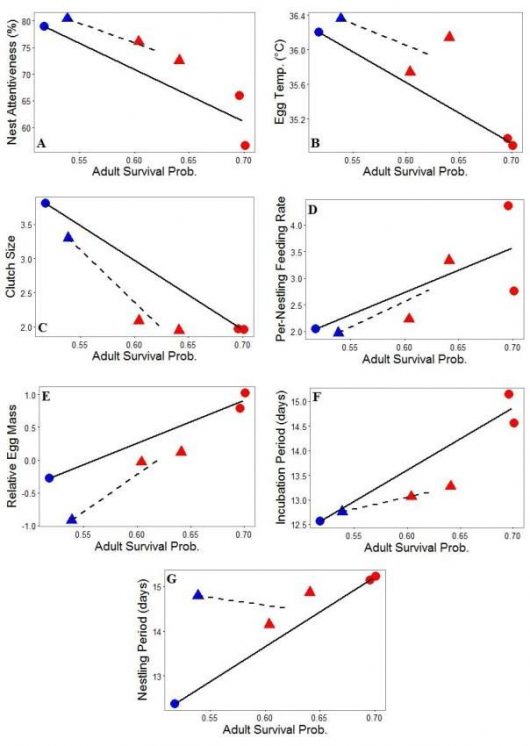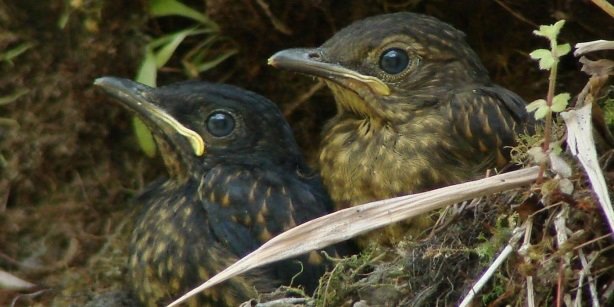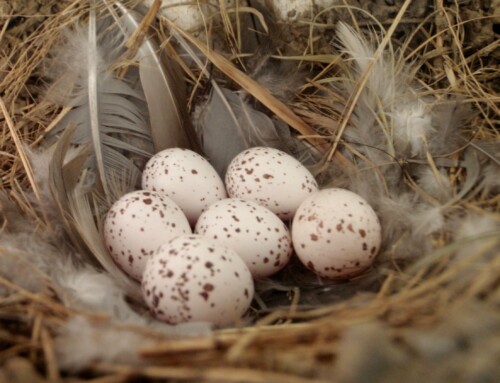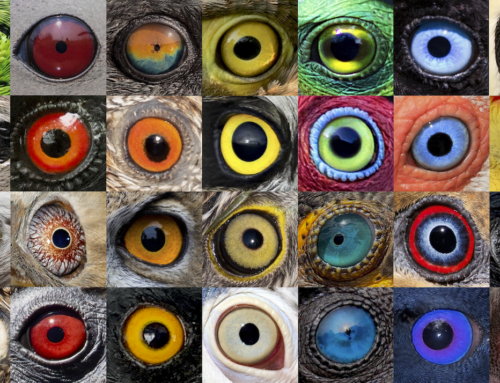Contrasting life-history evolution in New World thrushes
LINKED PAPER
Contrasting latitudinal patterns of life-history divergence in two genera of new world thrushes (Turdinae). Boyce, A.J. & Martin, T.E. 2017. Journal of Avian Biology. DOI: 10.1111/jav.01113. VIEW
None of us, human, plant or bird know when our time will come. Nevertheless, mortality is a powerful driver of evolution, and the probability of death shapes how organisms live. Our recent study of Catharus and Turdus thrushes finds that adult mortality probability drives different patterns of life-history variation across latitudes in these two groups of birds.
All organisms are bound by trade-offs that constrain how they live, feed and reproduce. For example, some species live longer and produce relatively few young while others have shorter lives but produce more offspring per reproductive attempt. There is a fundamental trade-off between these traits that prevents the existence of “Darwinian Demons,” organisms that have both long lives and produce many offspring. As a result, all species fall on a “slow-fast” continuum. Those on the fast end of the spectrum are short-lived, produce many young, develop quickly and invest a relatively small amount in each of their offspring. Slow species are the opposite. They are long-lived, produce few young, grow slowly and invest heavily in each of their young. In birds, species that live in the tropics fall almost invariably on the slow end of this continuum and temperate species on the fast end (Martin 2015).
Despite extensive study, debate remains about why tropical birds have slow life-history strategies in contrast to their temperate relatives. Alternative hypotheses suggest that differences in nest predation rates, seasonality, adult survival probability or food limitation across latitudes may explain the latitudinal gradient in avian life-history strategies. To test these hypotheses, we studied the life-history strategies, rates of nest predation and adult mortality probability in Turdus and Catharus thrushes. We conducted field studies at long-term sites (Fig 1) and compiled data from the literature. We chose these two genera because evidence suggests the life-history strategies of Turdus thrushes do not differ dramatically between temperate and tropical species (Snow and Snow 1963, Johnston et al. 1997, Martin et al. 2000, 2015), unlike most other groups of birds. Our premise was, if we study a group whose traits appear to vary in a normal way across latitudes and a group that shows an anomalous lack of variation, we should be able to tease apart what factors are driving that difference.

Our results confirm that Turdus thrushes, such as the American Robin or Common Blackbird, showed less trait variation than Catharus between temperate and tropical species. This pattern is consistent based on both field and literature data. We rejected seasonality as an explanation as all species in our field studies coexisted and thus both genera were subject to the same differences in climate and seasonality. Nest predation did not explain why Turdus were less variable across latitudes as nest predation rates did not vary consistently across sites based on our field data or across latitudes in general based on our literature search. We also found no differences in total feeding rate across latitude in either genera, suggesting slow life history strategies are not due to decreased food availability in tropical regions.
Our results provided unequivocal support for the adult survival hypothesis. Based on 21 (Arizona) and 7 (Venezuela) years of banding, recapturing and resighting wild birds at our sites, we found that species in both genera were longer-lived in the tropics, but the difference in adult survival probability across latitudes was much larger in Catharus. On average, annual survival probability was 35% higher in tropical Catharus, and only 16% higher in Turdus. Data from the literature showed a similar pattern. This means that while tropical Catharus thrushes live much longer than their northern counterparts, the average lifespans of Turdus thrushes are fairly similar regardless of where they live. This pattern explains why traits related to parental care, development rates and clutch size differ more among latitudes for Catharus and are relatively similar in Turdus (Fig 2).

Our work suggests interspecific variation in adult survival probability drives the latitudinal gradient in avian life-history strategies. Additionally, the fact that two closely-related clades differ dramatically in magnitude of life-history variation across latitudes highlights a relatively unknown axis of variation meriting further study. While our results provide evidence that adult survival probability is a strong driver of life-history variation, our work reinforces the fact that we do not fully understand the factors causing variation in survival probability across species.
References and further reading
Johnston, J.P., Peach, W.J., Gregory, R.D. & White, S.A. 1997. Survival rates of tropical and temperate passerines: a Trinidadian perspective. The American Naturalist 150:771–789. VIEW
Martin, T.E. 2015. Age-related mortality explains life history strategies of tropical and temperate songbirds. Science 349:966–970. VIEW
Martin, T.E., Martin, P.R., Olson, C.R., Heidinger, B.J. & Fontaine, J. J. 2000. Parental care and clutch sizes in North and South American birds. Science 287:1482–1485. VIEW
Martin, T.E., Oteyza, J.C., Boyce, A.J., Lloyd, P. & Ton, R. 2015. Adult mortality probability and nest predation rates explain parental effort in warming eggs with consequences for embryonic development time. The American Naturalist 186:223–236. VIEW
Snow, D.W. & Snow, B.K. 1963. Breeding and the annual cycle in three Trinidad thrushes. The Wilson Bulletin 75:27–41. VIEW
Image credit
Featured image: Pale-eyed Thrush, Turdus leucops, nestlings © Daniel Munoz-Saez
If you want to write about your research in #theBOUblog, then please see here.





